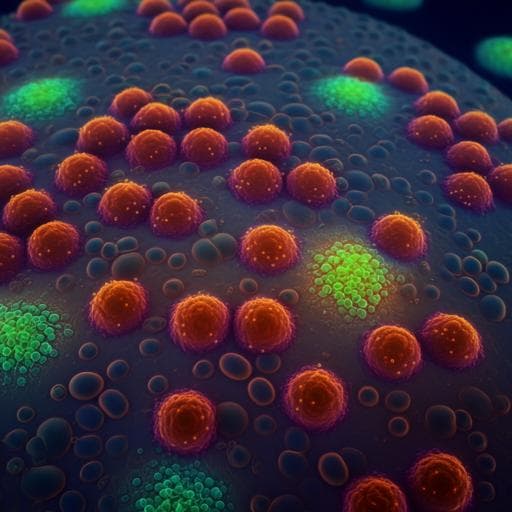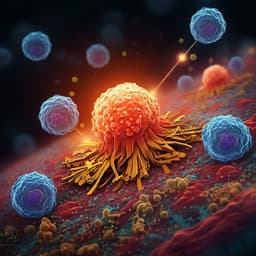
Environmental Studies and Forestry
An integrated metagenomic and metabolite profiling study of hydrocarbon biodegradation and corrosion in navy ships
C. R. Marks, K. E. Duncan, et al.
Discover how marine microbial communities are at the forefront of accelerating fuel and infrastructure deterioration in US Navy vessels. This groundbreaking study by Christopher R. Marks, Kathleen E. Duncan, Mark A. Nanny, Brian H. Harriman, Recep Avci, Athenia L. Oldham, and Joseph M. Suflita unveils the intricate relationship between hydrocarbon biodegradation and metal biocorrosion in ballast tanks.
~3 min • Beginner • English
Introduction
The study addresses how mixing diesel fuel and seawater in seawater-compensated ballast tanks on naval vessels influences microbial community succession, hydrocarbon biodegradation pathways, and associated corrosion of ship infrastructure. In the Anthropocene, with large increases in oil and steel production, understanding the interplay of fuels and steel—especially in marine environments—is critical. Historical reports linked fuel souring and ballast tank corrosion to sulfate-reducing bacteria, and recent standard protocols have shown many fuel components are susceptible to anaerobic biodegradation producing corrosive sulfides. The authors hypothesize that in situ ballast tanks represent microcosms where microbial communities undergo rapid shifts from aerobic to anaerobic conditions, leading to distinct hydrocarbon degradation pathways and measurable corrosion, and they aim to characterize these processes over time using metagenomics, metabolite profiling, and geochemical analyses.
Literature Review
Prior Navy reports (1960s–1990s) documented corrosion in fuel ballast tanks and storage systems and implicated marine sulfate-reducing bacteria. Corrosion (“wasting”) was noted on submerged surfaces, with large SRB populations in oil tankers. Standardized protocols have since evaluated biodegradation susceptibility of fuels and biofuels, showing anaerobic biodegradation links to sulfide production and corrosion, with impacts from organosulfur content, FAME inclusion, feedstocks, processing, hydrocarbon structure, and next-generation biofuels. Laboratory incubations with San Diego Bay seawater and F-76 diesel linked sulfidogenesis to pitting and generalized corrosion in carbon steel and Cu-Ni alloys. Literature also documents rapid enrichment of hydrocarbonoclastic aerobes (e.g., Marinobacter, Alcanivorax, Cycloclasticus) following marine oil inputs (e.g., Deepwater Horizon) and details anaerobic hydrocarbon activation pathways (notably fumarate addition) by Deltaproteobacteria coupled to sulfate reduction.
Methodology
- Study design and sampling: Fluids were collected from the expansion tank valves of three Arleigh Burke-class Navy destroyers using fuel-compensated carbon steel ballast tanks with Cu-Ni sluice pipes. Ship ballast residence times were approximately 1 week (Ship #1), ~20 weeks (Ship #2), and 32 weeks (Ship #3). Controls included San Diego Harbor seawater (intake source) and a comparator research vessel with carbon steel ballast tanks that did not mix fuel and seawater (Ship NF). Samples were shipped on ice and stored at 4 °C.
- Sample handling: For each Navy ship, aliquots were preserved for DNA extraction (250 mL + DNAzol), metabolite profiling (1 L acidified to pH<2 with 6 N HCl), and chemical/metals analyses (>250 mL, unpreserved). Ship NF ballast was pumped through an access hatch and preserved with DNAzol.
- Geochemical analyses: Dissolved oxygen measured in the field (optode). Nitrate and sulfate quantified by ion chromatography. Dissolved metals (Mn, Fe, Ni, Cu) measured by atomic absorption spectroscopy with graphite furnace after 0.45 µm filtration and acid dilution; six-point calibration (0–40 mg/L), triplicate measurements with periodic standard checks. Suspended particulates were collected anaerobically on 0.45 µm filters and characterized via field emission SEM with EDX to determine metal sulfide composition.
- Microbial enumeration: Direct epifluorescence microscopy after fixation (formaldehyde) and DAPI staining; counts averaged over ≥30 fields. qPCR quantified bacterial and archaeal 16S rRNA genes and picoeukaryote 18S rRNA genes (primer sets: Eubac8F/338R, A8F/344R, 345F/499R). Sulfate reduction genes aprA and dsrA were quantified by qPCR (specified primer pairs). Results reported as gene copies mL−1.
- DNA extraction and sequencing: Filters (0.45 µm) were stored at −80 °C and extracted using established protocols. Shotgun metagenomes were sequenced on Illumina MiSeq. Adapters trimmed (Cutadapt); reads quality-trimmed and paired (Trimmomatic); only paired reads retained.
- Community composition: Unassembled paired reads with SSU rRNA homology (Silva reference, ≥70% identity) were extracted (USEARCH) and analyzed in QIIME (closed-reference OTU clustering at 97% similarity; diversity metrics computed after rarefying SSU reads to 1800 per library). Additional single-copy marker (rpoB) fragments were tallied.
- Functional gene annotation: Translated homology searches against KEGG with DIAMOND (sensitive mode, top hit, E<1e−5). Anaerobic hydrocarbon activation genes were identified using the AnHyDeg database (acceptance: ≥60% aa identity over ≥35 aa). Functional gene abundances were normalized by rpoB hits. Total hydrocarbon-activating capacity was estimated by summing length-normalized hits to selected aerobic (alkB, etbAa, tmoA, todC1, dmpB/poxC, nahAc, 1-methylnaphthalene hydroxylase-like) and anaerobic (ebdA, assA, bssA, nmsA) activation genes.
- 16S rRNA amplicon sequencing: V3–V5 region amplified with M13-519F/785R and barcoded; sequenced on MiSeq; reads stitched, demultiplexed, clustered, and chimera-checked using QIIME.
- Metabolite profiling: Acidified waters analyzed for diagnostic metabolites of aerobic and anaerobic hydrocarbon activation using targeted GC–MS and global metabolomics per established protocols. Metabolites indicative of BTEX, PAH, and aliphatic degradation were targeted (e.g., alkylcatechols, dihydrodiols, succinate adducts, acids, alcohols).
- Thermodynamic modeling: Equilibrium solubilities of carbonate and sulfide minerals of Mn, Cu, Ni in seawater calculated with MINEQL 5.0 at pH 8.2, I=0.5 M, 25 °C, total carbonate 2 mM; closed system without CO2(g) and H2S(g).
Key Findings
- Community shifts with residence time:
- Harbor seawater: Mixed marine community with Alphaproteobacteria, Flavobacteria, Gammaproteobacteria, and abundant eukaryotes; aerobic alkane monooxygenase (alkB) present (12.4% of activation genes); no anaerobic activation genes or diagnostic metabolites detected.
- Ship #1 (≈1 week): Dominant Gammaproteobacteria (Alteromonadales, Oceanospirillales, Thiotrichales); aerobic hydrocarbon degradation potential strongly enriched. Fold-changes vs harbor: ethylbenzene dioxygenase (etbAa) +366×; xylene monooxygenase (xylM) +92.6×; phenol hydroxylase (dmpL/poxC) +8.0×; catechol 2,3-dioxygenase (catE) +11.4× to 25.3% of community; catechol 1,2-dioxygenase (catA) to 2.5%. Aerobic metabolites detected: phenylethanol, 3- and 4-methylcatechol, methylnaphthalenediol. Slight gene increases for assA (2.1%), bssA (0.3%), nmsA (1.2%) but no corresponding anaerobic succinate metabolites. Dissolved O2 decreased (3.7 mg/L vs ~7 mg/L harbor).
- Ship #2 (~20 weeks): Increased Deltaproteobacteria (21% total; Desulfuromonadales dominant), decreased Gammaproteobacteria proportion; aerobic activation genes declined (<2% for etbAa, xylM, phenol hydroxylase). Anaerobic naphthylmethylsuccinate synthase (nmsA) enriched to 7.7% (+440% vs Ship #1). Nitrate reductase genes (narG, napA) combined up to 38% (vs 9% harbor). Limited metabolite/genomic evidence for direct fuel decay by Desulfuromonadales; likely utilization of aerobic catabolites.
- Ship #3 (32 weeks): Dominant anaerobic Deltaproteobacteria (43.3%; Desulfobacterales 66% of Delta, Desulfarculales 27%, Desulfovibrionales 6%). Sulfidogenesis genes markedly enriched: aprA, phsA, and dsrA increased 4×, 5×, and 5× respectively vs Ship #2; community contained 27.0% adenylylsulfate reductase and 24.8% thiosulfate reductase. Anaerobic hydrocarbon activation genes at highest levels: assA 5.7%, bssA/hbsA/ibsA 4.7%, nmsA 20.5%. Diagnostic anaerobic succinate adduct metabolites for mono- and polyaromatics detected; no catechols or dihydrodiols. Sulfate decreased from 29 mM to 25 mM (~4 mM depletion over ~8 months).
- Microbial abundance and diversity: Total cells in ships ~10^5–10^6 mL−1 vs harbor 2×10^6 mL−1. Bacteria 16S copies peaked in Ship #1 (6.44×10^7 mL−1), declined in Ships #2–#3 to ~10^5–10^6. Archaea low (10^2–10^3 mL−1). Picoeukaryotes abundant in harbor and markedly reduced in ballast. Shannon diversity modestly decreased from harbor to ships; increasing dominance (lower evenness) with longer residence time.
- Corrosion indicators and metals: Dissolved metals elevated in ballast relative to harbor. After ~1 week (Ship #1), Mn, Cu, Ni increased ~4.5–15×. Ship #3 showed very high Mn (1119 µg/L), with Mn >> Cu, Ni; Fe and Ni elevated especially in Ship #2 (Fe 4276 µg/L, Ni 1564 µg/L). Particulates predominantly copper sulfides, then nickel sulfides, fewer iron sulfides; Mn sulfides not detected. Patterns indicate biogenic sulfide production and corrosion of carbon steel tanks and Cu-Ni sluice pipes; metal sulfide precipitation increased with sulfidogenic taxa (highest in Ship #3). Thermodynamic considerations and measured concentrations support loss of protective oxide layers and active biocorrosion.
- Overall successional pattern: Rapid shift within 1 week to aerobic hydrocarbonoclastic taxa and aerobic degradation; over 20–32 weeks, community transitions to anaerobic, fumarate addition-driven hydrocarbon degradation with increased sulfidogenesis, concomitant with geochemical signatures of corrosion.
Discussion
The findings demonstrate that seawater-compensated fuel ballast tanks rapidly select for hydrocarbon-degrading microbial communities whose metabolic strategies evolve with oxygen depletion over time. Initially (≈1 week), aerobic Gammaproteobacteria dominate, driving oxygen-dependent activation and ring-cleavage pathways for the more soluble diesel aromatics, as evidenced by enriched dioxygenase/monooxygenase genes and detection of catechols and dihydrodiols. As residence time increases (~20–32 weeks), oxygen becomes limiting and the community shifts to anaerobic Deltaproteobacteria that couple fumarate addition-based activation of aliphatic and aromatic hydrocarbons to sulfate/thiosulfate reduction, producing sulfide. Diagnostic succinate adduct metabolites and enriched aprA/phsA/dsrA corroborate active anaerobic hydrocarbon metabolism. These successional shifts parallel observations in oil-impacted marine waters (e.g., Deepwater Horizon) and indicate ballast tanks function as microcosms of hydrocarbon-impacted marine ecosystems in the dark.
Corrosion indicators track these biological changes: dissolved and particulate metals (Mn, Fe, Ni, Cu) increase relative to seawater, with metal sulfide particulates and solubility constraints implicating biogenic sulfide in undermining protective oxide layers, particularly in Cu-Ni sluice pipes (Ships #1–#2) and aggressive pitting of carbon steel at longer residence (Ship #3). The study thus links temporal microbial succession and hydrocarbon metabolism directly to microbiologically influenced corrosion, underscoring operational risks of mixing fuel and seawater in ballast systems.
Conclusion
This integrated metagenomic, qPCR, metabolomic, and geochemical investigation shows that diesel–seawater contact in Navy ballast tanks rapidly transforms marine microbial communities from aerobic hydrocarbonoclastic assemblages to anaerobic, sulfate-reducing communities employing fumarate addition pathways. The metabolic transition is corroborated by diagnostic metabolites and coincides with elevated dissolved metals and metal sulfide particulates indicative of biocorrosion, particularly of Cu-Ni piping initially and later carbon steel tank pitting.
Operational implications include recognizing that biodegradation and corrosion proceed regardless of oxygenation status, that cyclic oxygenation/deoxygenation may exacerbate corrosion, and that preventing sediment ingress and ensuring internal coatings may mitigate biofilm development and sulfidogenesis. Future research should resolve spatial stratification within tanks (beyond expansion tanks), quantify kinetics of community shifts under varying operational regimes, and evaluate mitigation strategies (e.g., coatings, flow management) to reduce biological wastage of naval infrastructure.
Limitations
- Variability among ships: Differences in operating practices, travel, and fuel use complicate direct between-vessel comparisons despite similar class, harbor, and inputs.
- Sampling constraints: Samples were taken from expansion tanks; representativeness of other zones (e.g., tank bottoms, stratified layers) is uncertain and warrants targeted spatial sampling.
- Comparator limitations: Insufficient DNA from Ship NF precluded metagenomic analysis, limiting direct comparison to a seawater-only ballast system.
- Gene annotation specificity: Some anaerobic activation gene tallies (e.g., assA/bssA/nmsA) may be biased by homology with other glycyl-radical enzymes, potentially inflating estimates at low abundance.
- Single-harbor scope: Findings derive from one harbor and a limited number of ships; generalizability to other environments and vessel classes requires further study.
Related Publications
Explore these studies to deepen your understanding of the subject.







